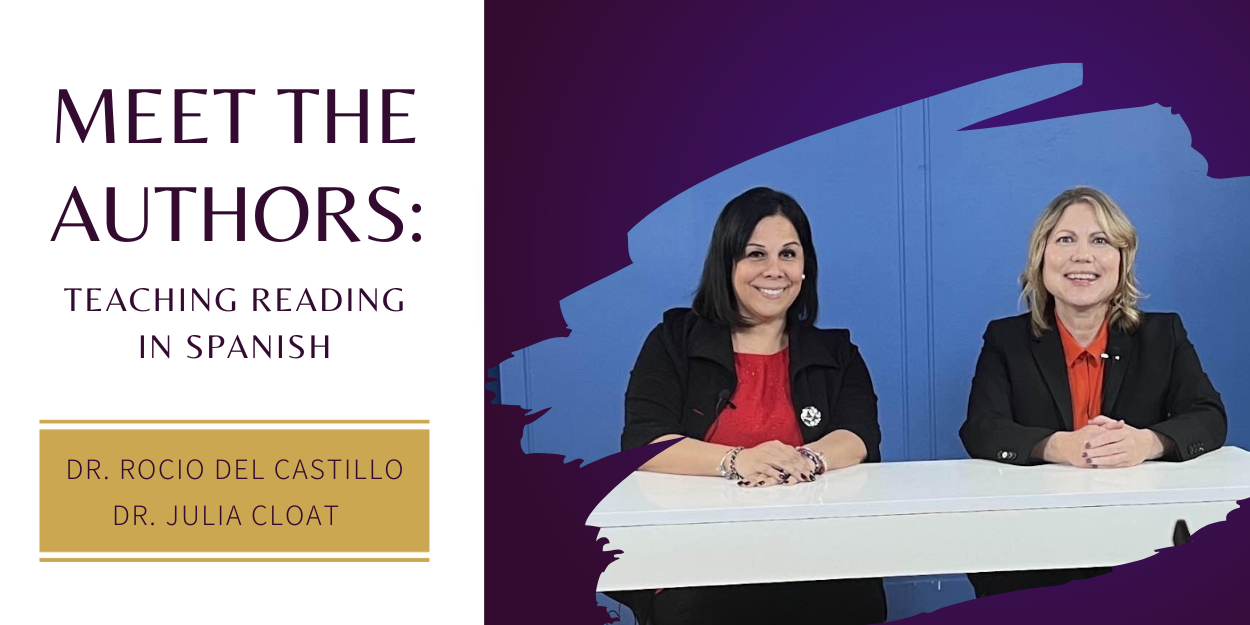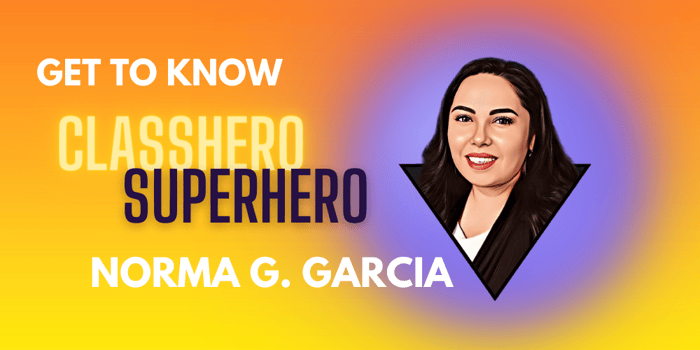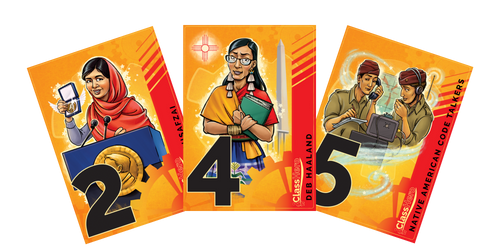Teaching Reading in Spanish: An Interview with the Authors
null • Nov 29, 2022 10:17:00 AM • Written by: Nikki

We had the honor of sitting down with Dr. Rocio del Castillo and Dr. Julia Cloat, the dream team behind Via Educational Consultants, on the eve of the release of their new book, Teaching Reading in Spanish, a Linguistically Authentic Framework for Emerging Multilinguals.
A True Partnership
Rocio began her career as a school psychologist in Peru where she volunteered as a firefighter to keep life well-rounded. She has dedicated her professional career to advocacy for educational equity and social justice, and has served for over 20 years in both public and private school systems in special education, bilingual, and dual language programs. She currently wears many hats as an Assistant Superintendent, an adjunct professor, and a principal consultant for Via Educational Consulting. She lives in Northern Illinois with her dedicated husband, Joel, her children, Nick and Bella, and two very spoiled pit bulls.
Julia, who is equally accomplished, still lives in the small town in rural Illinois where she grew up, and has spent the past 25 years working in Unit School Districts in roles including Literacy Specialist, Instructional Coach, and Curriculum Director. She is dedicated to equity, providing accessible learning experiences and the continuous improvement of teachers and currently works as an Associate Superintendent, adjunct professor, and principal consultant for Via Educational Consulting.
She doesn't let work consume her, though, and loves hiking, camping, and spending time with her husband Max and two children Olivia and Alexander.
The two educators met while working as Curriculum Directors in the same school district.
They felt an instant connection, built on mutual respect and shared values, which has developed into a beautiful partnership that intertwines their work and their families.
Given this, it makes perfect sense why they call their approach—outlined in Teaching Reading in Spanish—“The Spanish Reading Tapestry”; the two dynamic educators and researchers complement each other, finding unique ways to merge their individual strengths to weave a comprehensive, practical model for both emergent multilingual students and their teachers.
The Interview
ClassHero: What are the beliefs that have anchored your work?
- Julia: We're proud to say that everything we do is anchored in equity, additive multilingualism, asset-based pedagogies, and culturally and linguistically relevant instructional practices and methods.
- Rocio: Yes, and I'd like to add that we always put equity at the center of our work. This is our driving force and is the foundation that everything is built on. We consider equity a foundation, an approach, and a mindset. As educators, it's our responsibility to acknowledge institutional inequities. The type of institutionalized change that is needed for this mind shift to occur doesn’t happen through a single initiative or concrete practice. It depends on teachers to use their voices to ignite transformation and be their students' advocates.
CH: Tell us why you wrote your book, Teaching Reading in Spanish.
- Rocio: I have spent the majority of my adult life in education. Many of these years have been spent leading in Dual Language environments, so I intimately knew of the need for an authentic framework for teaching students to read Spanish. I wanted to find a way to help teachers, and to find an instructional approach that really works, while keeping in mind how that approach differs from teaching students to read English.
- When I partnered with Julia, she brought her English literacy expertise and a shared love of learning and books. Through the process of writing Teaching Reading in Spanish, we found ourselves reflecting a lot on our shared beliefs and values. We built an approach to teaching reading in Spanish that was equity-rooted and true to our experiences.
.png?width=682&height=546&name=Untitled%20design%20(1).png)
CH: Your book provides a Spanish reading framework based on "linguistically-authentic pedagogy, not on English-Language practices." In your own words, what is linguistically-authentic pedagogy, and how does it differ from a pedagogy based in English-language practices?
- Julia: Linguistically-authentic pedagogy is the instructional approach and materials that reflect students' languages and cultures. It begins with a belief in additive multilingualism and the benefits of drawing on different language systems. This is different from the common English-centric approach that values English over other languages, and English language acquisition over bilingualism or multilingualism.
CH: Why do teachers need to understand the difference between Spanish and English and why is teaching to read Spanish different from teaching to read in English?
- Rocio: It's not only about the differences, but the similarities too! It's important to acknowledge and be aware of both so that we can provide a more authentic, successful instruction for our students. If we create the environment where students are allowed to consider these similarities, they can use their emerging knowledge to develop multiliteracy skills, and this will lead to those cross-linguistic connections.
- Julia: Yes. Exactly that. It's also important for teachers to understand how teaching students to read Spanish diverges from teaching them to read English. The main differences are related to oracy, phonemic and phonological awareness, and phonics. For example, phonetic patterns in Spanish are much more reliable than in English, which really effects the pedagogical differences between teaching reading in the two languages. Oracy is absolutely crucial for teaching Spanish literacy as well. Letting students engage in this oral language helps their development and can be used often and at all grade levels.
- Even though phonemic awareness is essential to learning to read English, there isn't a lot of evidence that focusing on PA increases Spanish reading performance. Highlighting syllables is key to learning to read Spanish, and the greatest predictor of student success. Because these phonic patterns are so reliable, early readers of Spanish are able to decode with almost 100% accuracy by mid-first grade. Their same-age peers who are learning to read English decode with only about 40% accuracy.
- CH: If you had to pick one thing for your readers to remember from your book, what would it be? Why?
- Rocio: If we had to choose, I'd say I'd want our readers to walk away knowing how to build an equitable classroom community while following an authentic pedagogical framework, and with an understanding that multilingualism should be promoted as a strength in education. Emergent multilinguals, like all students, enrich our school with their cultural traditions and language. This, together with the dreams of the students’ families, shape our communities. Our current policies and practices characterize immigrants as linguistically deficient, but in truth these communities have always had their own stories to tell: stories of love, strength, resilience, and learning.
- Julia: In our book, we call this the Spanish Reading Tapestry. It's an asset-based approach to biliteracy that weaves together a tapestry of the key components of Spanish reading skills.

- CH: At ClassHero, we are on a mission to make math curriculum accessible to emergent multilingual students by supporting it in 37 languages. How do you both view the relationship between language and math?
- Julia: Math and language are truly interdependent. It's nearly impossible for students to access math content unless they also have learned the language of math. This connection is very important for teachers to understand if they want to provide their students with equitable ways to master the content they're learning in their math classrooms.
- Rocio: I agree, and math students should be encouraged to use all four domains of language (listening, speaking, reading, and writing). Quality math instruction is a place for students to work together and help one another think through activities and concepts. Students get to go beyond merely explaining a math problem—they're also able to learn the language of math and to apply ideas to different mathematical models.
- This is what we want because students are more likely to envision themselves as mathematicians and scientists later in life if they think of themselves as the creators of mathematical knowledge now.

CH: Recently, you were both nominated as ClassHero Language Superheroes. What is a language superhero to you and what is your co-author's
language superpower?
- Julia: Rocio is truly a superhero! One of her many superpowers is her ability to elevate other people. She recognizes strengths in others and builds on those assets so those around her can grow the superpowers within themselves. It's something I really admire about her as a business partner and friend.
- Rocio: Well, Julia is my superhero! I am constantly impressed by her capacity to build strong and meaningful relationships with everybody around her and her ability to see the best in people. Her power to connect with people, new cultures, and languages is so special. I'm very grateful to be partners.
Purchase Teaching Reading in Spanish here
Twitter: @ViaEdConsulting @CloatJulia @rpdelcastillo
Web: viaedconsultants.com
Register for our Webinar with the authors of "Teaching Reading in Spanish"
Nikki
Don't Miss Out On Another Cause
Sign up and Join Our Newsletter Today
.png?width=638&height=319&name=Rocio%20and%20Julia%20Blog%20Assets%20(2).png)


